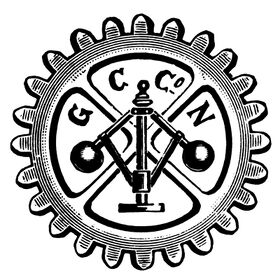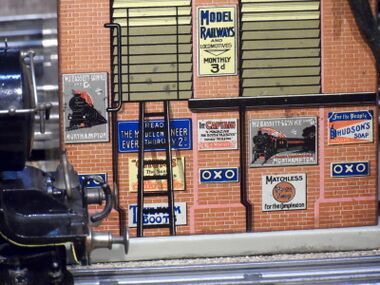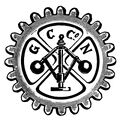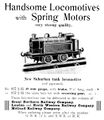Category:Georges Carette
| Toy Brands and Manufacturers |
|---|
Georges Carette |
| 1890s - 1916 |
Fine printed detail on a Georges Carette lithographed gauge 0 water tower, showing advertising posters and convincing "fake 3D" shadowing and highlighting effects [image info]
A restored Georges Carette Stirling Single [image info]
Georges Carette hot- air engine, circa ~1910-12 [image info]
Front cover of "The Great Toys of Georges Carette (1975 catalogue reproductions) [image info]
Georges Carette (1861-1954) moved from France to Germany in the late C19th, and founded his company Georges Carette & Cie. in the toymaking region of Nuremberg.
Originally manufacturing tinplate toys, Carette graduated to also producing steam-powered models in the early C20th (see: Carette Stirling Single).
The "Carette" name is probably best known in the UK for the gauge 0 coaches that Carette made for Bassett-Lowke.
History
1886-~1895
Carette's original company was co-founded with the Bing brothers Ignaz and Adolf in 1886, with the idea being that the company would work exclusively as a supplier and contractor for Bing. The company had a substantial workforce and factory at Schillerstrasse 5 , Nuremburg producing pieces for Bing in a wide range of materials.
This original company was dissolved after about ten years (in ~1895), with Ignaz and Adolf pulling out, and a new company was formed with just Georges in control. Since the original company wasn't really an independent manufacturer, and was essentially a fabrication house for Bing, it tends to be ignored.
Pre-war
When we think of "Georges Carette et Cie", we normally think of this "new" independent company founded in the mid-1890s. The new business produced a range of then-fashionable metal toys such as magic lanterns (not surprisingly, given their "Bing" background) but specialised in products fabricated from lithographed metal sheet. A shop was also opened in 1896 as a partnership between Georges Carette and Paul Joseph Thal, and with the exception of the factory burning down in 1903, the company seemed to be on a positive track. Carette got a British patent for an improved gear slide for model locomotives, litho'ed tinplate model locomotives were followed by more substantial steam-powered models, and Georges struck up a working relationship with Bassett-Lowke to supply models designed for the British market.
World War One
Carette's status as a French national became a problem with the outbreak of World War One in 1914. As a foreigner living in Germany and owning a factory, his assets were liable to be seized, and the factory was put into administration in 1914, with Friedrich Pergher put in charge. Georges and his wife found it advisable to leave Germany and head back to France, and further wartime legislation resulted in an order in 1916 for the company to be liquidated. By 1918, the company's status was "in liquidation".
Closedown
With the selling-off of the company's assets, the tooling and designs for the British-style locos and carriages was bought by Bassett-Lowke, who then continued selling essentially the same Carette range that they'd previously been importing, but making them themselves using the Carette tooling, in Britain.
The "Continental" model railway-related assets were acquired by Karl Bub.
Styling
The physical lines of Carette's pieces are often noticeably more elegant (and perhaps more sophisticated) than those of the company's Nuremburg neighbours - Carette's stationary steam engines often had cleaner lines and were unafraid to use simple cylinders and shapes, in cases where the prevailing Nuremberg style would have tended to treat a large unadorned area as something that required knobs or additional cast detailing. Carette's turn-of the century pieces had a less "Gothic" look to them, and it's interesting tocompare the museum's Carette Stirling Single locomotive, which celebrates the clean lines and styling of the original locomotive with its contemporary "Bing for Bassett-Lowke" "Black Prince" loco, which has more "lumpy" shape and "piecrust" styling
Chromolithography
Chromolithography was the Victorian predecessor of modern "offset litho" printing, and was often used for high-quality colour illustrations in children's books, and for art prints. Unlike modern offset litho, which is a mechanical four-colour process that splits an image into four separate "dotty" colour separations for Cyan, Magenta, Yellow and Black ink ("CMYK"), with positional offsets to allow all four colours to be printed on the same sheet, the original method involved artists starting with whichever combination of inks they wanted, and then drawing the required lines and stippled dots by hand for each type of ink that they wanted to use or overlay. This printing system allowed more impressive results than the (faster and cheaper) mechanistic system that replaced it - an "offset litho" reproduction of a landscape painting would have to try to use a "CYMK" approximation of the colours used, and might show crude artefacts, whereas an artist-produced chromolithograph might use ten or more layers, with a colour palette of inks individually selected by the lithographer to produce the best match and gradation to the colours used in the original - the chromolithography might even use dedicated inks that matched the original paint colours used by the original artist, in which case the repro artist was essentially recreating the original work, perhaps in a more painstaking and technically adept manner than the original artist, since the original painter had the luxury of hand-mixing colours, whereas the litho artist had to analyse and then recreate the same gradations using fine stippling. The downside of using these hand-created lithographic prints was that it might take a highly skilled artist three months to create and then fine-tune a set of blocks or plates that could recreate a painting in lithographic form.
At its simplest, chromolithography might just use a set of solid colour blocks and lines printed onto a metal sheet with a given choice of colours. At its best, the process could replicate the finest hand-painting techniques - the only limitation being that the printing had to be done on a flat surface. A great example of the heights that Carette could achieve with the process can be seen on the two Carette water-towers in the museum - when looking at these pieces, it's difficult to remind oneself (until one looks down at the base) that ALL the front detail on the towers is fake - the recessed shutters, front ladder and buttressed brickwork complete with highlights and shadowing are all printed onto a simple flat surface. Even the advertising posters apparently plastered over the tower aren't really "applied" - they are part of the original printing, complete with tiny drop-shadows.
The Carette factory was justifiably proud of the range of printing processes that they had mastered for applying to tinplate, and Carette's "printed tin" pieces are often notable for their bright colours and the amount of sharp detail. Sometimes this was sophisticated and restrained (such as on the rich blue Cardean loco), and sometimes, when a more toyish look was required, it could be used to produce a cartoonish level of overdetailing that made one forget that the physical shape of the toy was actually quite primitive.
Books
- Allen Levy, The Great Toys of George Carette, reprint of 1905-1914 catalogues (New Cavendish, 1975) ISBN 0904568024
External links
- Carette boats (classic-collectables.com)
- Carette gauge 0 rolling stock (binnsroad.co.uk)
- Carette locomotives (tcawestern.org)
- Carette stationary steam (johno.myiglou.com)
- Georges Carette (German Wikipedia) - German-language
- Carette, Georges - Nürnberg (zinnfiguren-bleifiguren.com) - German-language
Subcategories
This category has the following 7 subcategories, out of 7 total.
0
- Carette gauge 0 (15 P, 15 F)
1
- Carette gauge 1 (14 P, 2 F)
2
- Carette gauge 2 (4 P)
3
- Carette gauge 3 (3 P)
C
- Carette buildings (5 P, 2 F)
M
- Carette miscellaneous (2 P, 6 F)
R
- Carette road vehicles (3 P, 1 F)
Pages in category ‘Georges Carette’
The following 41 pages are in this category, out of 41 total.
B
C
G
H
L
- LNWR Baggage Car 1332 (Georges Carette)
- LSWR Baggage Car No133 (Carette for Bassett-Lowke)
- LSWR Baggage Car No133, gauge 1 (Carette for Bassett-Lowke)
- LSWR Passenger Carriage 1328 (Carette for Bassett-Lowke)
- LSWR Passenger Carriage 1328, gauge 1 (Carette for Bassett-Lowke)
- Luggage/Guard Carriage NER 1335, gauge 3 (Georges Carette)
O
P
S
Media in category ‘Georges Carette’
The following 35 files are in this category, out of 35 total.
- Bassett-Lowke Caledonian loco launch 1910.jpg 769 × 470; 83 KB
- Bassett-Lowke CardeanLoco advert Nov1910.jpg 771 × 1,196; 147 KB
- Bassett-Lowke grey high-sided wagon (Carette for Bassett-Lowke).jpg 1,200 × 719; 687 KB
- Bassett-Lowke red high-sided wagon (Carette for Bassett-Lowke).jpg 1,200 × 719; 667 KB
- Caledonian Railway Official Models enamelled tinplate plaque.jpg 601 × 800; 259 KB
- Caledonian set, Bassett-Lowke, model review (MRaL 1909-12).jpg 686 × 1,024; 138 KB
- Cardean Bassett-Lowke train set, advert (MRaL 1909-12).jpg 640 × 1,024; 106 KB
- Cardean locomotive detail (Carette for B-L).jpg 1,024 × 768; 399 KB
- Cardean train set, advert (MRaL 1910-01).jpg 666 × 1,024; 108 KB
- Colmans Mustard Traffic van (Carette for Bassett-Lowke).jpg 1,200 × 719; 228 KB
- CR brown open wagon (Carette for Bassett-Lowke).jpg 1,200 × 721; 638 KB
- Express Locomotive 2350, 509-, Georges Carette (CGcat 1911).jpg 2,200 × 999; 496 KB
- GE grey open wagon (Carette for Bassett-Lowke).jpg 1,200 × 720; 640 KB
- George Carette loco 1632 detail with maker's mark.jpg 2,000 × 2,000; 1.74 MB
- Georges Carette, logo, 1911.jpg 800 × 800; 175 KB
- Great Northern Railway Express Locomotive, 927-, Georges Carette (CGcat).jpg 1,200 × 550; 157 KB
- High Class Hot Air Engine, Georges Carette (CGcat 1911).jpg 1,200 × 630; 219 KB
- Hot-air engine, 1910-1912 (Georges Carette).jpg 1,200 × 1,600; 1.23 MB
- Landaulette car, 3358-, Georges Carette (CGcat 1911).jpg 1,024 × 884; 266 KB
- Loco LNWR 513, 1722-, Georges Carette (CGcat 1911).jpg 1,200 × 807; 213 KB
- New Suburban Tank Locomotive, 957-, Georges Carette (CGcat 1911).jpg 1,044 × 1,200; 199 KB
- SECR Motor Train No1, 1601-, Georges Carette (CGcat 1911).jpg 1,600 × 1,087; 280 KB
- SECR No1 Combined loco and coach (BLcat 1909).jpg 1,200 × 837; 197 KB
- SECR Steam Rail Motor Coach No1, gauge 0 (Georges Carette).jpg 2,000 × 1,124; 1.12 MB
- Stirling Single 2.5-gauge Carette assembled (Michael Edwards).jpg 2,358 × 1,527; 578 KB
- Stirling Single 2.5-gauge Carette in pieces (Michael Edwards).jpg 1,778 × 1,176; 200 KB
- Stirling Single 2.5-gauge Carette repainted (Michael Edwards).jpg 1,764 × 737; 172 KB
- Stirling Single 2.5-gauge Carette restored (Michael Edwards).jpg 3,990 × 2,508; 1.56 MB
- Stirling Single locomotive 776, Bassett-Lowke 1904 catalogue, cropped.jpg 3,541 × 2,037; 924 KB
- Stirling Single locomotive 776, Bassett-Lowke 1904 catalogue, small.jpg 1,024 × 639; 114 KB
- The Great Toys of Georges Carette, ISBN 0904568024.jpg 920 × 1,200; 531 KB
- Upright Hot Air Engine 686-, Georges Carette (CGcat 1911).jpg 984 × 1,600; 408 KB
- Vauclain locomotive 2350, steam-powered (Georges Carette).jpg 2,000 × 1,334; 1.38 MB
- Water tower, gauge 0 (Carette for B-L).jpg 1,600 × 1,200; 1.21 MB
- Water tower, gauge 1 (Carette for B-L).jpg 1,200 × 1,600; 1,010 KB











































